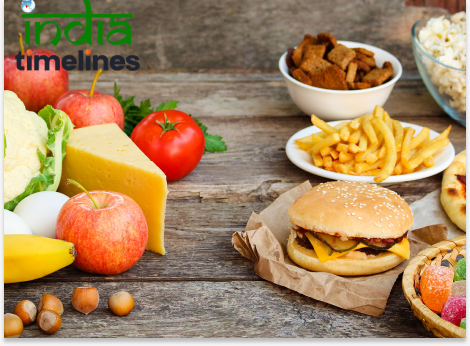
In today’s fast-paced world, the convenience of highly processed foods often overshadows the benefits of healthy, whole foods. As we navigate grocery aisles and dining options, understanding the differences between healthy and highly processed foods can help make informed choices that benefit our overall health. This blog explores the contrasts between these two types of foods, their impact on your body, and how you can make healthier choices.
Understanding Healthy Foods
Healthy foods, often referred to as whole or minimally processed foods, include a wide variety of natural, nutrient-dense options. These foods are typically high in essential nutrients and free from harmful additives.
Characteristics of Healthy Foods:
- Nutrient-Rich: Healthy foods are packed with vitamins, minerals, fiber, and antioxidants. Examples include fruits, vegetables, whole grains, nuts, seeds, and lean proteins.
- Low in Additives: They generally do not contain artificial colors, flavors, or preservatives. They are closer to their natural state, which means fewer processed ingredients.
- Balanced Macros: They provide a balanced mix of carbohydrates, proteins, and fats. For instance, a meal with grilled chicken, quinoa, and a side of steamed broccoli offers a balanced ratio of these macronutrients.
- Whole Ingredients: Healthy foods often include whole ingredients with minimal processing, such as fresh fruits, vegetables, and whole grains.
Benefits of Healthy Foods:
- Improved Health: Rich in essential nutrients, these foods help boost the immune system, support cardiovascular health, and promote overall well-being.
- Weight Management: High in fiber and protein, healthy foods can aid in maintaining a healthy weight by keeping you full longer and reducing overall calorie intake.
- Better Digestion: The fiber content in whole foods supports healthy digestion and regular bowel movements.
What Are Highly Processed Foods?
Highly processed foods, also known as ultra-processed foods, are manufactured using industrial processes and often contain numerous added ingredients. These foods are designed to be convenient, shelf-stable, and flavorful, but they come with several downsides.
Characteristics of Highly Processed Foods:
- Added Sugars and Fats: They often contain high amounts of added sugars, unhealthy fats, and artificial ingredients. Common examples include sugary cereals, sodas, and packaged snacks.
- Artificial Additives: These foods frequently include artificial preservatives, colors, and flavors to enhance taste, appearance, and shelf life.
- Low Nutritional Value: Highly processed foods are typically low in essential nutrients and high in empty calories. They often lack the vitamins, minerals, and fiber found in whole foods.
- Refined Ingredients: They use refined grains and processed oils, which have been stripped of their natural nutrients and fiber.
Drawbacks of Highly Processed Foods:
- Health Risks: Consuming high amounts of processed foods has been linked to increased risks of obesity, heart disease, diabetes, and other chronic conditions.
- Nutrient Imbalance: These foods can lead to nutrient imbalances as they often lack essential vitamins and minerals and are high in unhealthy fats and sugars.
- Addictive Qualities: The combination of sugar, fat, and salt in processed foods can be addictive, leading to overconsumption and unhealthy eating patterns.
Comparing Nutritional Value
To better understand the differences between healthy and highly processed foods, let’s compare their nutritional profiles:
Healthy Food Example: Fresh Apple
- Nutrients: Rich in vitamins C and A, fiber, and antioxidants.
- Benefits: Supports immune function, aids digestion, and provides natural energy.
Highly Processed Food Example: Apple-Flavored Snack Bar
- Nutrients: Often high in added sugars, artificial flavors, and preservatives.
- Drawbacks: Provides empty calories with little to no beneficial nutrients, leading to potential weight gain and health issues.
Making Healthier Choices
1. Read Labels Carefully: When shopping, read ingredient lists and nutrition labels. Opt for foods with shorter ingredient lists and those that include whole, natural ingredients.
2. Prioritize Whole Foods: Focus on incorporating more fruits, vegetables, whole grains, and lean proteins into your diet. Fresh and frozen options are often better than their canned or pre-packaged counterparts.
3. Cook at Home: Preparing meals from scratch allows you to control the ingredients and avoid unnecessary additives. Experiment with healthy recipes that use fresh, whole foods.
4. Limit Added Sugars and Fats: Reduce consumption of foods high in added sugars and unhealthy fats. Instead, choose healthier alternatives like fruits, nuts, and whole grains.
5. Stay Hydrated: Drink plenty of water and avoid sugary beverages. Water supports overall health and can help manage hunger and appetite.
Practical Tips for Transitioning to Healthier Eating
- Start Gradually: If transitioning from a diet high in processed foods, start by incorporating one or two healthy foods into your meals each week. Gradually replace processed items with whole foods.
- Meal Planning: Plan your meals ahead of time to ensure you have healthy options readily available. This can help prevent reaching for processed snacks when you’re hungry.
- Healthy Substitutes: Look for healthier alternatives to your favorite processed foods. For example, swap out sugary cereals for oatmeal topped with fresh fruit or yogurt.
- Snack Wisely: Choose snacks that offer nutritional benefits, such as raw veggies with hummus, fresh fruit, or a handful of nuts.
Conclusion
Understanding the differences between healthy and highly processed foods is crucial for making informed dietary choices. Healthy foods, rich in essential nutrients and free from artificial additives, support overall well-being and help prevent chronic diseases. On the other hand, highly processed foods, with their added sugars, unhealthy fats, and artificial ingredients, can negatively impact health and lead to various health issues.
By focusing on incorporating more whole, nutrient-dense foods into your diet and reducing your intake of highly processed items, you can improve your health, boost your energy levels, and enjoy a more balanced and nutritious diet. Remember, small changes can make a big difference—start with one healthy choice today and build from there for a healthier future.






























